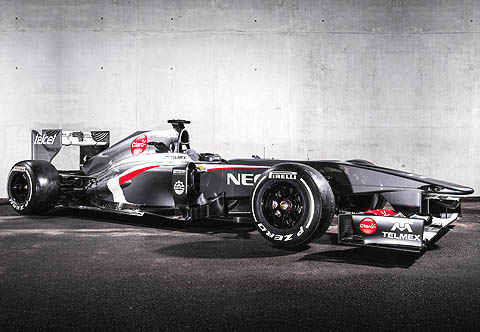


02/02/2013
NEWS STORY
 |
Sauber is the fifth team to unveil its 2013 contender, the C32, which was launched at the team's Hinwil HQ, being a very different proposition visually from its predecessor.
A year ago almost all the cars on the grid had one particular feature in common: a stepped nose. This design element caused an outcry among many fans, but was rendered nigh-on unavoidable by the regulations. For 2013, the FIA has allowed a cosmetic fairing to be used in this area, while retaining the current chassis and structural nose height regulations.
The nose now sweeps down smoothly towards the track, which not only improves the car’s looks, but, more significantly, enhances the aerodynamics of the front end.
With the front wing, the Sauber aerodynamicists have put their faith in a proven formula, further optimising last year’s development and thus improving its aerodynamic efficiency.
The engineers also remained true to the basic concept of the front suspension, carrying out only minor adjustments.
The sidepods of the C32 are notably slimmer than the Formula One norm up to now and are responsible for giving the new car a very distinctive look. “The airflow in this area has a major influence over everything that happens at the rear of the car,” said Chief Designer, Matt Morris, offering a glimpse into the team’s thinking.
The significantly reduced volume of the sidepods over conventional variants makes packaging a particular challenge. Even the smallest empty space has been used to accommodate the countless components.
An extremely slim rear end was high up the engineers’ list of priorities. One of the key aspects here is the arrangement of the radiators, which is very different from that in the C31. A look at the rear end of the new car reveals the engineers’ rigorous approach to this area.
“It is one thing the aerodynamicists coming up with great ideas," said Morris, "but they are often difficult to make into reality. In this respect, the design and production team has done a fantastic job on the side pods, both from a structural and packaging perspective.”
The aerodynamicists have also invested a lot of time developing the details around the exhaust exits – an area which has a major impact on performance and in which the Sauber team was one of the leading exponents last season.
As before, the car’s KERS (Kinetic Energy Recovery System), engine and gearbox are supplied by Ferrari. The KERS is based on last year’s version, but its weight and packaging volume have been optimised.
The rear axle is a totally new development. Although it still works according to the pullrod principle, its layout has been designed to better interact with the airflow around the rear of the car, while further improving the tyre management.
There is also potential for improvement in how the tyres are used in qualifying, as Morris explained: “Our car looked after its tyres very well during races last year. However, we had problems now and again when it came to getting the maximum out of them in qualifying. We’ve looked at this phenomenon closely and made the required adjustments.”
Double DRS systems are banned in this year’s technical regulations and the sporting regulations now stipulate that, during qualifying, DRS can only be activated in those areas of the circuit where it is permitted during the race. The demands placed on the aerodynamic efficiency and rear wing design, are therefore slightly different now. “We expect this to be an area where we see various developments introduced over the course of the season,” said Morris.
Another high priority was reducing the car’s overall component weight, to allow a better distribution of the ballast, while retaining its structural requirements and mechanical setup flexibility. “My colleagues have done an excellent job here, and we have even exceeded our original targets”, praised Morris.
Like last year, Sauber will use a basic version of the car for its rollout event and introduce a major update before the first race of the season.
“We have set ourselves lofty goals with the Sauber C32-Ferrari, and I’m confident that we’ll be able to meet them," summed up Morris. "The C31 gave us a very good basis, to which we’ve made further improvements. Our aim is to line up for 2013 with a car that is competitive from the first race, but which also offers extensive potential for further development.”
Asked her expectations for the coming season, team boss Monisha Kaltenborn said: "This is another of those questions one is asked every year, and it's always a tricky one to answer. What I can say is that we're well prepared, that we've got the new car finished in good time and that we've met the performance targets we set ourselves internally.
"That puts us in a confident frame of mind," she added. "But we'll only really find out what it all amounts to at the first race of the season in Melbourne."
"We need to build on the solid basis of last year and reach some good results," added Nico Hulkenberg, who joins the Swiss outfit from Force India. "But it is a whole new season: New game, new luck! We really have to wait and see what happens when we hit the track for the first time. And then we'll take it from there."
"In the beginning the most important task is to solve all the car's reliability issues so we can put in a lot of laps in the tests," said rookie Esteban Gutierrez. "Then, of course, another important factor is to get to know the car in race and qualifying conditions, which mainly comes with experience during the first races.
"With the progress the team has made in the previous years, I expect that as a team we will keep going in this same direction in order to reach our goals," he added.
Check out our C32 gallery, here.